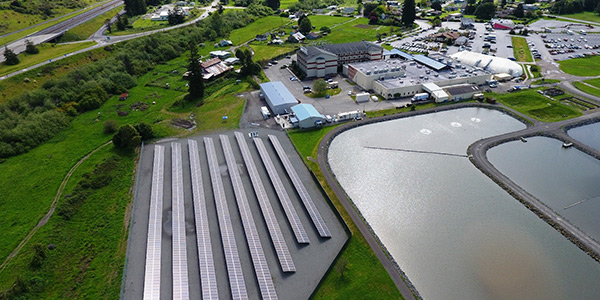The California Public Utilities Commission ordered the state’s investor-owned utilities to take steps to hasten the creation of microgrids Thursday, including establishing a $200 million incentive program for communities most at risk from public safety power shutoffs (PSPS).
It was the latest in a series of measures the commission pushed through in the past year in an effort to mitigate impacts when utilities intentionally shut off power to prevent electrical equipment from igniting wildfires. (See Calif. Rushing Microgrids for Fire Season Shutoffs.)
“This decision is the culmination of a whirlwind year … for microgrids and the resiliency team,” CPUC President Marybel Batjer said. The commission issued two major decisions in one year when a single decision generally takes 18 months, she said. “This has been nothing short of a whole lot of hard work done very quickly.”
The commission unanimously approved a proposed decision on Track 2 of their microgrid rulemaking to facilitate local generation and distribution that can operate independently of the larger grid in emergencies. It ordered the state’s three large IOUs — Pacific Gas and Electric, Southern California Edison and San Diego Gas & Electric — to each adopt new microgrid tariffs and to collectively create a $200 million program to incentivize microgrids in underprivileged communities that are most vulnerable to PSPS.
“This decision builds on our efforts to reduce barriers for the commercialization of microgrids while keeping an eye to ratepayer equity and supporting vulnerable and low-income communities,” Commissioner Genevieve Shiroma, who led the effort, said in a statement.
The adoption of microgrids was fast-tracked by Senate Bill 1339, passed in 2018. The bill requires the CPUC to implement microgrid standards, rates and tariffs, and reduce barriers to microgrid deployment.
The commission retooled its rulemaking to focus on microgrids and resilience ahead of the 2020 fire season. It established a new section in its Energy Division devoted to the matter and opened the rulemaking in September 2019.
In Track 1 of the rulemaking, the commission ordered IOUs to streamline and expedite interconnection processes for microgrid resilience projects and to work with local and tribal governments to bring the projects online by late summer 2020. The plan called for utilities to standardize application processes for microgrids, to expedite signoffs on installed projects and to increase staffing to accelerate interconnections. (See CPUC Proposal Would Promote Microgrids.)
The CPUC also approved controversial plans by PG&E to deploy hundreds of diesel generators to power substations and key facilities for the 2020 fire season. It expressed dismay at the idea of using diesel fuel amid the state’s push for clean energy but said it was the only immediate solution to widescale power outages.
Track 2
Dozens of parties commented on the Track 2 decision. Some argued it placed the development of microgrids in the hands of the large IOUs responsible for starting wildfires instead of letting affected communities have more input.
“We urge the commission to reject the current proposed decision and to include the voices of Black, indigenous and people of color in making revision to the proposed decision that will include control and ownership in development of these resources in those communities,” said Barbara Stebbins, a member of San Francisco Bay Area advocacy group Local Clean Energy Alliance’s steering committee. “The current proposed decision gives almost complete control over microgrid development to the investor-owned utilities,” which runs contrary to the intent of SB 1339, she argued.
The commission shared those concerns but praised the decision’s incentive program, which it said would lessen the likelihood that wealthier communities would have their own backup power while poorer communities would not.
“I appreciate the caution that’s taken in looking at how these rule changes and potential tariff changes will impact the entire rate base,” Commissioner Martha Guzman Aceves said. “I actually appreciate the incentive approach in order to guard from leaving the customers behind who probably need it the most, certainly in the scenario of a PSPS event.”
The commission also told utilities to find clean energy approaches to backup power by 2022 to replace the diesel generators.
“This decision addresses resiliency to keep customers energized for the upcoming 2021 fire season, including a transition plan to clean backup generation for 2022 and beyond,” Shiroma said. “We will continue to actively engage with stakeholders to make the grid more resilient for all.”



